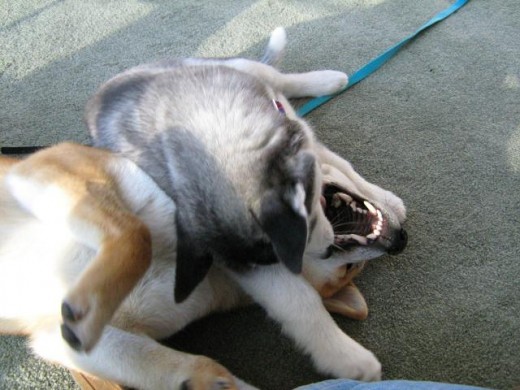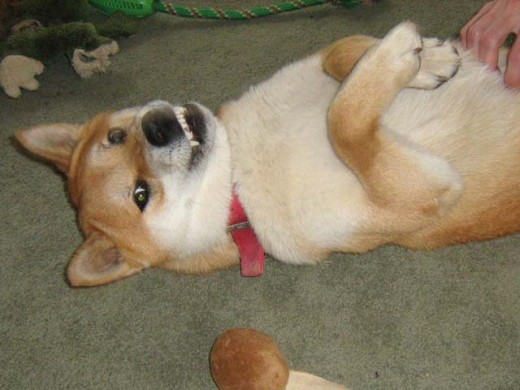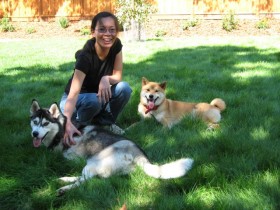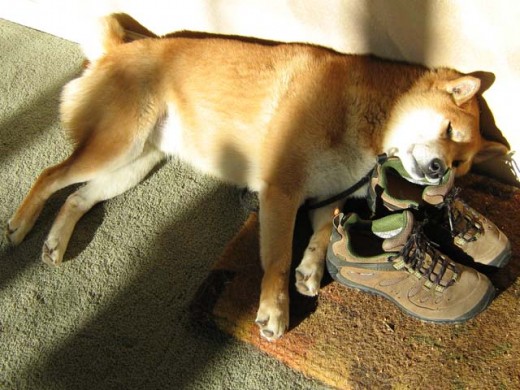Why do puppies bite?
Unlike us, puppies do not have opposable thumbs, so they manipulate stuff with their mouths, in the same way that we manipulate stuff with our hands. New puppies or young dogs will try to put everything into their mouths, because they are curious about objects and their surroundings.
Therefore, puppy biting is normal canine behavior.
Puppies also play with each other through play-biting. When a puppy bites too hard during play, his siblings may yelp and stop interacting for a short duration. Biting too hard on an adult dog (e.g. their mother), may also result in an undesirable consequence. In this way, puppies learn social rules and boundaries.

There is nothing wrong with dogs or puppies biting each other during play, but it is crucial to teach them to be careful with their mouths when interacting with people.
A puppy who is not taught this lesson, may become a danger to all the people around him, including his owners. Play-biting with humans, especially seniors and children, may cause accidental injuries and ultimately result in forced euthanasia.
If our puppy is biting us or others in an uncontrolled way, it is best for everyone not to engage in rough play with him. Also, do not play games that encourage biting such as Tug-of-War.

How to Deal with Puppy Biting
I deal with puppy biting by training my dog in three important areas –
1. Bite inhibition training
People have thinner and more sensitive skins than dogs do. Therefore, one of the first things that I teach my puppy is to control the force of his bites, especially when interacting with me and others.
2. Redirection and no-bite conditioning
When my dog bites on people, clothing, or unsanctioned objects (e.g. books, wires), I no-mark to let him know that it is an undesirable behavior. Then, I redirect his mouth onto something acceptable, and reward him for doing the right thing. In this way, he learns which objects are off-limits, as well as what he should do instead.
3. Excitement and self-control
An over-excited puppy, who lacks self-control, will tend to bite more often and with greater force. By managing my puppy’s excitement level and teaching him to control his impulses, I set him up for success, and reduce the number of instances where he engages in bad biting behavior.
An ounce of prevention is worth a pound of cure.
~~[Benjamin Franklin]
When dealing with puppy biting issues, I always try to stay calm but firm. I do my best to catch problems early on, and fix them before they escalate in degree and frequency.
If a dog is causing puncture wounds, or escalating his aggressive biting behavior, it is best to get professional help as soon as possible.
In this article, I discuss bite inhibition training and no-bite conditioning. For more on managing a puppy’s excitement level, please refer to Managing Puppy Excitement and Self-Control.
Bite Inhibition


Some dogs may have low bite thresholds. This means that they resort to biting or aggression even with fairly low, seemingly harmless stimuli.
One of my dogs, a Shiba Inu, can get mouthy when he is excited or frustrated, when I restrain him, when I stop him from doing something, and much more. Because of this, it is extremely important to train him to have good bite inhibition.
I start bite inhibition exercises as soon as I bring a puppy home. Even though puppy teeth are sharp, a puppy does not have the jaw strength of an adult, and is not capable of doing as much damage. Once my puppy has a soft mouth, I train him to stop biting on people.
Hand-feeding is a good way to teach our puppies to control the force of their bites. I hand-feed my puppy at least some of his kibble every day. If he bites too hard when getting his food, I do a sharp ouch or yelp, and ignore him for a few seconds. This teaches him that if he bites too hard, the food stops.
If my puppy is taking food from me gently, I praise him and keep the food coming. Often, I will combine hand-feeding with puppy obedience training and dog grooming sessions. Hand-feeding can also help prevent food aggression issues, so I continue this practice throughout my dog’s life.
We can also get Ian Dunbar’s book After You Get Your Puppy, for an overview of bite inhibition training.
Initially, Dunbar may come across as somewhat alarmist. We may feel that if we do not meet his somewhat unrealistic dog socialization and puppy training demands, things are going to go badly. I just try to ignore the alarmist talk, and focus on the bite inhibition and handling exercises, which are quite useful.
I am very thankful that my puppy (now adult dog) has a soft mouth. Because my Shiba Inu has good bite inhibition, we were able to solve many of his subsequent issues, which would have been difficult to deal with if he were biting at full strength.

When Our Puppy Bites …
When our puppy bites, it is important NOT to jerk our hand away. If we jerk away, we will likely get scratched. In addition, sudden and quick movements may make our puppy think that it is a fun game. This rewards the biting behavior, and encourages him to bite on us even more.
In the worst case, quick movements can activate a dog’s prey drive, and encourage aggressive behaviors. Therefore, it is important to control this reflex action, and stay still. In addition, I give a no-mark or yelp as a puppy might do to his litter-mates, when they are playing too rough.
I usually yelp when it is an accidental dog bite, for example when my dog gets his teeth on me while taking food out of my hand. Yelping is also appropriate for puppies that are still learning the rules. Otherwise, I use No for adult and adolescent dogs, who should know better.
After the no-mark, I always follow-up with a positive command, e.g. redirect him onto a toy.

1. Redirect Our Puppy onto a Toy

This technique is especially useful for an untrained puppy. It lets him know that it is ok to bite on a toy, but not ok to bite on people.
For example, my dog gets excited and starts biting when I scratch his tummy. Therefore, I used that as a training exercise to get him to bite on a toy, instead of on my hand. Since I can start the exercise anytime I want, I control the environment and make sure that I have multiple soft toys nearby for use. I make sure to reward my dog very well with food and affection when he redirects, so that I further reinforce the behavior.
A toy can also be useful for those cases where the puppy is losing control, and getting a bit too excited or frustrated. Giving him something to redirect his excitement or frustration at, may help to calm him down.
If I do not have a toy handy, I can also redirect by giving my puppy an alternate and simple command that he knows very well, e.g. Sit.

2. Withdraw Attention and Affection
Often, a puppy starts to bite at us because he wants to play or interact. Therefore, if my puppy does not respond to my redirect, then I withdraw my attention and affection. I do this by standing up, folding up my arms, and ignoring him. I make sure not to give any eye contact, not to talk, and not to engage him in any other way.
This is also called a timeout lite.
By doing this, my puppy learns that-
Out of control biting and jumping = No play, no attention, and no affection,
Gentle interaction = Play continues, food rewards, and extra attention.
Sometimes, my puppy may get too excited and escalate his behavior by biting on feet, or jumping and trying to bite on clothing. This is something that I absolutely do not allow because it can be very dangerous, especially with children and the elderly.
If my puppy escalates his behavior, I no-mark, say “Timeout”, and take him to a low stimulus timeout area immediately.
NOTE – In general, I try to set my dog up for success by managing his excitement level. In this way, I keep timeout-necessary episodes to a minimum.
3. Timeout

Most dogs value their freedom to roam around the house and backyard. Dogs are also pack animals, and like being with both human and canine members of the family. Since a timeout takes away both of these things, it is an extremely effective method of dog discipline.
When giving my dog a timeout –
- I make sure to put him in a really boring room, with no windows that he can reach. Currently, my dog’s timeout area is the laundry room.
- I check that the room is safe, and contains nothing that he can chew, play, or interact with in any way.
- Finally, I ensure that nobody gives puppy any attention during his timeout period.
It is better not to use a crate for timeouts. Crates are useful for transportation, management, and more. Therefore, I ensure that the crate is a happy place, where my dog feels comfortable going to for some peace and quiet, for sleep, and to chew on his favorite toy.
I find that a timeout is the most effective way to stop my dogs from biting. However, I only use it when my puppy is deliberately acting out, and not for accidental bites.
Initially, I start with a short 1 minute timeout. If my dog continues to bite right after he comes out, I return him to the laundry room for a much longer period of time (about 15 minutes). Be flexible with the timeout duration, and adjust it according to our dog’s age, temperament, and behavior. Some trainers do not believe in long timeouts, while others may ignore their dogs (timeout lite) for hours.
Do not use timeouts for training mistakes or lack of motivation.

How to Stop Puppy Biting
Some trainers suggest using aversive techniques to stop dog biting. For example, one suggested making my hand into a fist (so my fingers are safe), and then pushing my fist gently in when my puppy bites. This is uncomfortable for the puppy, and he will likely release our hand.
While it did get my puppy to release my hand, it did not reduce his biting behavior. In fact, my dog responds badly to any aversive methods. Doing this made him want to bite on me even more, because he got a reaction, and now has something (my fist) to fight with.
The same thing occurred with spraying water on his muzzle; he just started attacking the water bottle.
Ultimately, aversive techniques were not very effective with my dog, and caused even more behavioral issues. With aversive methods, it is difficult to trick a puppy into thinking that the bad stimulus is not coming from us. This can compromise a puppy’s trust and weaken our bond with him.
Instead, when my puppy bites,
- I first use a no-mark, for example, No or Ack-Ack to let him know that it is an undesirable behavior.
- Then, I redirect him onto a toy or give him an alternate command, for example Sit. If he stops biting and follows the command, then I praise him and reward him with attention and a fun game.
- If he continues to bite, I start with a timeout-lite by first withdrawing my attention. I do this by standing up, folding my arms, and turning away from him.
- If he escalates his behavior and starts to jump or bite on my clothing, then I quickly remove him to his full timeout area.
I always try to set my dog up for success by managing his excitement level. When he starts biting, I try to redirect and turn things into a positive learning experience. I only escalate my response when I absolutely have to, and I try my best to minimize those instances.

Hi Asherlééi.
The situation you describe is actually a pretty common one. It happens when different people in the house treat the dog differently. As a result of this, the dog may see us and him as belonging to the same pack, and our parents as being in a different pack, i.e. outsiders. The dog may growl or show aggression to protect his own pack from outsiders (our parents). He may hump because he does not know that the behavior is undesirable by us.
It is probably best to get help from a positive reinforcement trainer. A trainer will be able to observe the dog and accurately diagnose the key issues. A trainer will also be able to give us detailed instructions and show us what we need to do to fix things. Visit this site to find a trainer near you:
http://www.apdt.com/po/ts/default.aspx
To fix this issue, it would probably be most effective if everyone participates. Everyone should have a hand in training, feeding, and doing other activities with the dog so that he sees the whole family as his pack. I usually have a very consistent set of house rules, that everyone applies in the same way. This allows us to communicate more clearly to our dog and prevents confusion. I also make sure to only reward my dog (including affection, food, freedom, etc.) when he is doing something good and desirable. Many people make the mistake of giving affection to a dog all of the time, even when he is misbehaving, and this encourages the dog to keep repeating those misbehaviors.
I also follow the NILIF program to give my dogs a fixed structure and a fixed routine.
http://shibashake.com/dog/nothing-in-life-is-free-dog-training
I also do frequent, but short obedience training sessions with all of my dogs every day.
The best thing though, is probably to get help from a professional trainer.
My dog is quite older , he is addicted to me and stays away from my mum and dad he humps my leg and growles if anyone shouts at me or touches me and has bite 3 times hes a lovable bichon frise but I cant fix this problem no matter what advice I get , I really need help and my stupid dad says that if he ever bites him he will get him put down immediatly i’m sooo worried Its partly my fault because I never discipline him but can anyone help ?. WB immediatly before its too late Thanks Vry much
I would start with having the child toss a treat to him first. Make sure to only do this when he is calm and not being insistent about wanting the food – i.e. nosing, whining, etc. Make sure that the dog never uses aggression to try and “bully” the food from the child.
Generalizing the training to a variety of kids will definitely help, but it is important to only do this with kids who are good about following instructions and who can stay calm, so that the dog doesn’t get distressed during the training sessions. It can often be a challenge to find kids who are willing to do this 🙂
Definitely consider getting a professional trainer. The aggression may come from a variety of reasons. A good trainer will be able to read the dog and accurately identify the root of the aggression. Good luck! Let me know how it goes.
Very helpful advice especially about the desensitization techniques. Will check out that show on National Geo also. It’s amazing how quickly people (even our vet) tell us to get rid of our dog, but I would like to have some hope that things will get better. You give me some hope. I would even be willing to try a trainer specifically for this isuue too. One more thing… would you have the child give him a treat sometimes too, when he is behaving well around her? Do you think the training will help him be better around other kids in general too, if we just train him around our child? We put a muzzle on him when we walk him because kids run up to him (he is tiny and cute so very hard to resist) and he has snipped at them.
Thank you for the wonderful advice- you know dogs for sure!
I think that most dogs can be retrained, but (why is there always a but?) it may take a lot of time, and the end result may not always be perfection. It is easier to teach dogs when they are young because then, their mind is open to new experiences, and they are very eager to learn. It is also easier to prevent a behavior than it is to break a bad habit that has already been reinforced time after time.
The most important thing about fear aggression, I think, is the energy of the humans around the dog. Usually, when a dog shows aggression, our natural reaction is to become fearful ourselves, and that will make the dog even more fearful and more aggressive – leading to a vicious cycle. For now, you may want to put a basket muzzle on your dog when he is around children. This usually helps to put everyone at ease because there is less danger of anyone getting hurt. Only do this if your dog is not stressed or fearful of the muzzle or it may worsen the problem.
Do controlled desensitization exercises several times, every day. First start off the dog at a distance from the child. It has to be far enough so that the dog is still calm. Ask the child to ignore the dog. Reward and praise the dog for being calm in the presence of a child. It also helps to ask the dog for some simple commands, e.g. “watch”, “sit”, and reward him for doing that in the presence of a child. Then you can *slowly* reduce the distance. If the dog starts acting out, then you have moved too close, too quickly. Move back and restart. Make the sessions short and fun so that your dog starts to associate good things with children, and learns not to be fearful of them. At other times, give the dog a nice quiet area away from children, so that he does not practice his aggression.
Have you seen the show DogTown on NatGeo? They are a dog shelter, and they often take in many dogs with aggressive histories and then retrain them. I really enjoy the show and it always makes me feel very hopeful. Last season they even took in Michael Vick’s dogs and retrained them. Quite amazing.
I would definitely try desensitization exercises and consult a positive reinforcement trainer trainer on this. In cases of aggression, it always helps to have a trainer observe the dog and identify what exactly is causing the dog distress, and the level of distress. Hope this helps. Please let us know how things go.
I have tried some of these techniques but my chihuahua has learned to fear children from past experiences before we owned him. He has scratched my nephew’s skin with his teeth- never punctured skin. Now we have a toddler and he snarls and jerks his neck toward her as if to bite, but doesn’t. THe vet told us to get rid of him soon. If a dog has a bad past- we got him when he was 1 and now he’s 5- is there any hope for re training. He autmoatically reacts in fear toward kids, but our child has never hurt him- she is vey gentle and always monitored around him.
Thanks for visiting ellie. How serious are the fights? Break skin? puncture wounds? Do they also bite people in the house? How serious are those bites? What have you tried so far?
If the fights are serious (e.g. puncture wounds) it is best to get a professional trainer, who is familiar with these more dominant, powerful, breeds, to come over and help. There is usually a lot going on wrt. body language, triggers, etc. that may lead to a fight, and a trainer will be able to observe the root of the problem and address that.
In the meantime, it may be best to manage the dogs so that they are always supervised when they are together. In general, I find that it is best to stop my dogs from practicing any kind of aggression. Exercise will also help. The more tired my dogs are, the less frustrated energy they have, which can frequently trigger a fight.
my dog keep fighting what do i do iv tryed everthing so far.sometimes they are the nices things ever.they are a bull-dog&a boxer.the bull-dog mostly starts the fights but then my boxer goes him.AHHHHH!they are called frank&bruno.the boxer is called bruno&the bull-dog must be called frank!
Hi Jim. Thanks for sharing your story. Most dog bites I think are preventable with some training and management. And it is probably not a matter of liking you or not, but rather responding to the type of energy you were projecting. It has been my experience, with my own dogs, that when I project fearful energy, they start acting out.
I think it is really awesome that your past experience did not prevent you from getting a dog of your own. She sounds like a really fun and balanced dog.
I am thankful for the hub. I was bit by the same dog twice when I was little. It was my aunt’s dog and I don’t remember doing anything that could have provoked him. The first time I was patting him normally I had been around other dogs without issues. (So I don’t think it was me, but I was about 10.) I guess he was tired of it and bit my hand. The next time we had a cookout. I was just getting my food and he stood in front of me then lunged at me and bit me in the face. I think that dog bit my cousin too. But not badly. From what I can remember my uncle always played very roughly with him. But I think he just didn’t like me.
Well on a more pleasant note. Last year my family and I got the perfect dog. She is part Black Lab and part Chow. She is the friendliest and kindest dog I’ve ever seen. She did mouth a little as a puppy and the vet suggested yelping whenever she touched skin and it worked great.